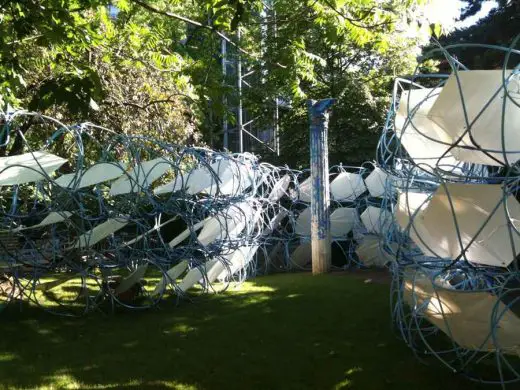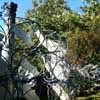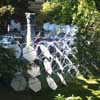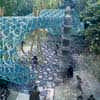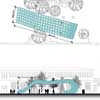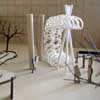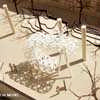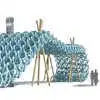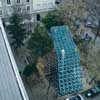Pavillon Spéciale 2012 Paris, Competition, Ball Nogues Studio Design, Image
Pavillon Spéciale 2012 Paris
Ecole Spéciale d’Architecture, France design by Ball Nogues Studio
9 Jun 2012
Pavillon Spéciale 2012
Paris, France
Design: Ball Nogues Studio
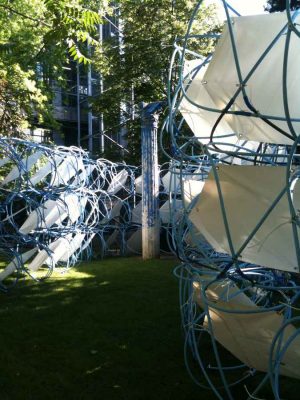
photograph © Ball Nogues Studio
Pavillon Speciale 2012
The Ecole Spéciale d’Architecture in Paris this evening; with the presence of Benjamin Ball and students from the 6th Semester Atelier 3x of the Ecole Speciale, inaugurated the 2012 Ball-Nouges studio ‘Pavillon Speciale’. This marks the 2nd edition of the summer architecture series that gives young emerging international architects the opportunity to build with students a temporary project in the heart of Paris.
Curated and conceived by Matteo Cainer in the summer of 2010, the series is an ongoing program of innovative temporary structures built by emerging international architects under the age of 45. Once a year, students of the Ecole Spéciale d’Architecture have the opportunity to build, along side the selected architect, a new experimental pavilion for the large rectangular outdoor garden that is an essential part of the School. The uniqueness of the “Pavillon Spéciale” is that it establishes a bridge between the architectural profession and academia, becoming therefore an integral part of the educational program of the school.
Architect:
The Pavilion is a unique structure, in architecture terminology; the phrase that describes a system whose form is derived from the deformation of its materials under force is “form active.” This type of structure is difficult to study using software. It often requires architects to explore their designs by testing full-scale mock-ups, and using that empirical information to help inform the process of digital modelling, which is studied in the studio rather than in the field.
The structure is comprised of approximately 200 “cells”, each made from locally sourced plastic tubing that will be bent and curled in custom jigs designed and constructed by students. To provide shade, each cell will have a locally sourced sheet material spanning between the tubes within it. The cell module is a very effective way of constructing a temporary structure: each can be transported as a flat unit and rapidly assembled on site; when it is time for the structure to come down, dismantling and transportation to a new site is easy.
Location:
Ecole Spéciale d’Architecture
254 Boulevard Raspail
75014 Paris, France
http://www.esa-paris.fr
Curator Pavillon Speciale: Matteo Cainer
Project: Ball Nogues Studio, Los Angeles, United States Studio Assistant: Baptiste Bonijoly
Ecole Spéciale Students:
Antoniotti Bruno, Bellanger Alexandra, Bennis Selim, Boinot Julien, Bruel Laura, Budin Olivier, Cargill Maxime, Claudet Ariel De Lacvivier Matthieu, Delalande Nicolas, Dubois Nina, Ducroux Hubert, Fishler Raphael, Fournier Adrien, Haudrechy Felix, Hudson Leo, Lambert Pierre, Liagre Victoire, Maleyrat Jean, Merle Daubigne Ariane, Mougel Raphael, Noury Pola, Pradeau Pauline, Seguin Pauline, Veryra Camille, Wertheimer Astrid.
Previously:
19 Mar 2012
Pavillon Spéciale 2012
Paris, France
Design: Ball Nogues Studio
Paris March 19th 2012, The Ecole Spéciale d’Architecture in Paris announces Ball Nogues Studio from Los Angeles (USA), as the winner of the 2012 edition of the “Pavillon Spéciale” competition in Paris, France.
Now in its 2nd edition, the “Pavillon Spéciale” consolidates its role as an annual spring architectural series that gives young emerging international architects the opportunity to build with students, a temporary project in the heart of Paris. Curated and conceived by Matteo Cainer in the summer of 2010, the series is an ongoing program of innovative temporary structures built by emerging international architects under the age of 45. The uniqueness of the “Pavillon Spéciale” is that it establishes a bridge between the architectural profession and academia, becoming therefore an integral part of the educational program of the school. Once a year, students of the Ecole Spéciale d’Architecture have the opportunity to build, along side the selected architect, a new experimental pavilion for the large rectangular outdoor garden that is an essential part of the School. The short timescale, 3 months from design to construction, provides a unique model that presents a strong synergy between architecture and education and with talks before during and after construction, it becomes a contemporary platform for architectural experimentation inviting as a result, the wider public to interact with students, professionals and the city itself.
Ball Nogues Studio, this year’s winner, drawn among 8 finalists, will design with students an installation that will create a sense of place while providing a respite from the sun and rain. ‘The Pavilion is a unique structure, in architecture terminology; the phrase that describes a system whose form is derived from the deformation of its materials under force is “form active.” This type of structure is difficult to study using software. It often requires architects to explore their designs by testing full-scale mock-ups, and using that empirical information to help inform the process of digital modeling, which is studied in the studio rather than in the field. Students will therefore engage in this iterative design process with Ball Nogues.
The structure is comprised of approximately 200 “cells”, each made from locally sourced plastic tubing that will be bent and curled in custom jigs designed and constructed by students. To provide shade, each cell will have a locally sourced sheet material spanning between the tubes within it. The cell module is a very effective way of constructing a temporary structure: each can be transported as a flat unit and rapidly assembled on site; when it is time for the structure to come down, dismantling and transportation to a new site is easy’. The Pavilion is due to open at the beginning of June at the Ecole Spéciale d’Architecture at 254 Boulevard Raspail in the 14th district of Paris.
The International jury composed of Iñaki Abalos(Ábalos+Sentkiewicz Arquitectos, Spain), Jean-Max Collard (Architectural Journalist Les Inrocks, France), Massimiliano Fuksas(Studio Fuksas, Italy), David Keuning (MARK magazine, Netherlands), Claude Parent (Architect, teacher and writer, France) together with Odile Decq (Director of The Ecole Spéciale d’Architecture) and Marie-Hélène Fabre (Academic Head of the Ecole Spéciale ) and a student from the school found that the winning entry had the most potential since it presented various qualities, from being very interesting architecturally, to economically feasible and at the same time ecologically strong. “More and more in construction we see the use of plastic and in this sense it is a very contemporary material therefore to see it used in this way is very interesting”. The jury felt that it was an especially manual project that could actively involve the students. Furthermore, the jury found that this proposal had the most potential in offering a real possibility of design involvement and a genuine pedagogic challenge for the students. In addition it is conceived as a pavilion and as a real protected gathering space with a Jacques Tati feel.
The other finalists for this year’s edition were: DUS Architects from Amsterdam (NL), Fantastic Norway from Oslo (NO), MOS from New York (USA), OSMD from Lisbon (PT), Polaris Architects from Luxembourg (LU), Softlab from New York (USA), and Sou Fujimoto Architects from Tokyo (JP). An exhibition of the 8 finalists’ proposed projects will opened the day of the inauguration of the project in June at the Ecole Spéciale d’Architecture
Pavillon Spéciale Paris – Further Information
For the selection process, the Ecole Spéciale invites an external committee of international experts in the field of architecture, including curators, architects, critics, academics, and magazine editors. Each expert nominates 8 candidates among emerging practices who are experimenting with new styles or techniques and are under 45. These groups are then asked to submit portfolios of their work for review by an international jury. After assessing the candidates, the jury selects 8 finalists who are then invited to draw up a preliminary proposal for the designated site.
International Expert Committee for 2012 Pavillon Spéciale
Hitoshi Abe Chair of Department of Architecture & Urban Design UCLA (USA)
Stefano Boeri Founder and Director Stefano Boeri Architects (IT)
Cynthia Davidson Head of Any Corp, Chief Editor of Log (USA)
Eva Franch Director Storefront for Architecture NY (USA)
Pedro Gadanho Architect and Curator of the Department of Architecture & Design MOMA (USA)
Shinichi Kawakatsu Founder and Director RAD Architects (Japan)
Paul Petrunia Founder/publisher of Archinet.com, Bustler.net (US)
Hans Ulrich Obrist Co-Director Serpentine Gallery London (UK)
Ecole Speciale Studio Professors (INT)
“Pavillon Speciale” Commission
Odile Decq: General Director, École Spéciale d’Architecture
Matteo Cainer: Curator Pavillon Spéciale
Marie-Hélène Fabre: Academic Head
General Director
Odile Decq set up her own office just after graduating at l’Ecole de la Villette in 1978 while studying at Sciences Politiques Paris where she completed a post-graduate diploma in Town Planning in 1979. International renown was not long in coming, as early as 1990 actually, with her first major commission: the Banque Populaire de l’Ouest in Rennes. The numerous prizes and publications that distinguished the building underlined the emergence of a new hope directly born from the punk rebellion which turned old conventions upside down. From then on, ‘Odile Decq Benoît Cornette” was considered a tool for the future and the projects as desire generators. By questioning the commission, the use, the matter, the body, the technique, the taste, their architecture offers a paradoxical look, both tender and severe on today’s world. They were awarded with a Golden Lion in Venice in 1996. Alone since 1998, Odile Decq has been faithful to her fighting attitude while diversifying and radicalizing her research.
In 2007, Odile Decq has been elected General Director of the Ecole Spéciale d’Architecture in Paris. Since that, she shares her time between organizing the school in developing it to an international level.
Curator
Matteo Cainer is both an architect and a curator. Based between London and Paris, he is founder and director of Matteo Cainer Architects and Associate Professor at the Ecole Speciale d’Architecture in Paris.
Prior to opening his own office he worked and collaborated for several years with a number of celebrated international practices including Eisenman Architects in New York City, Coop Himmelb(l)au in Vienna, and Arata Isozaki Associati in Milano. In 2004 was Assistant Director to Kurt W. Forster for the 9th International Architecture Exhibition La Biennale di Venezia, METAMORPH and in 2006 he was appointed curator of the London Architecture Biennale with the show ‘The World in One City- A Sketch for London’.
Matteo has always been active in academia; he was visiting critic at the Bartlett School of Architecture, Pratt Architecture School, Columbia University and at the Dessau Institute of Architecture in Germany. In 2009 he starts teaching at École Spéciale d’Architecture, where he is now associate professor and Curator of the Pavillon Speciale project. The work of Matteo Cainer has received various mentions and has been published in numerous books and international magazines; furthermore he has written and edited a number of books and articles in the field of architecture and design.
École Spéciale d’Architecture, Paris
PRIVATE INSTITUTION OF HIGHER EDUCATION
In a society where all the productions tend insidiously to become standardized, disregarding any cultural, historic or social sense of identity, while the daily practice of architecture struggles with the standards imposed by the industry and the political powers and while the architecture of monuments settles indifferently on the surface of the globe, schools are the last guarantees of the variety of thought, positions and actions.
L’École Spéciale d’Architecture was established 140 years ago as part of a revolt against academism. Since then it has continuously recreated its teaching approaches and organizational structures. Among it’s teachers there have been two pritzker price winners : Jean Nouvel, and Christian de Portzamparc in addition to Paul Virilio.Today, as Europe’s institutions of higher education strive to harmonize their degrees and programs, a necessary reform that may have the unintended effect of producing uniformity, the École Spéciale stands firmly on its founding premise: to be special.
AN ARCHITECTURE SCHOOL
Being an architect today, more than ever before, means mastering a range of skills and acquiring a capacity to put forward and carry through projects. However, it also means:
– Joining and managing multidisciplinary teams
– Innovating and contributing to progress with methods and technology
– Experiencing the world but also the specific characteristics of each culture.
– Understanding complex situations and projects
– Possessing a capacity for analysis, conceptualization and an ability to adopt a clear stance.
AN ASSOCIATION LAW 1901
As an association organized under the law of 1901, the school offers a unique perspective on architecture in which alumni, faculty, students, and staff are invited to participate in an alternative culture of the architecture. Apart from the École Spéciale d’Architecture, only two other schools in the world have the same self-management; the Architectural Association in London and Sci-arch in Los Angeles.
A PRIVATE INSTITUTION
Institution of higher education, established in 1865, the École Spéciale d’Architecture (ESA) is France’s only private school of architecture, the only one to be a “Grande Ecole” and state-approved since 1870. ESA’s educational programs are accredited by the Ministry of Culture/Communication and by the Directorate of Architecture and Heritage. Its degrees are referred by the Ministry for Higher Education and Research.
BEING SPECIAL
Being Special means assuming the duty of diversity: the diversity of knowledge, the diversity of cultures and the diversity of practices with no preconceived ideology or sectarianism. It also means considering that the creation of architecture is first and foremost a research-based activity; It means pushing the boundaries of thought and traditional practices ever further, while at the same time ensuring a fuller understanding of architecture; It means encouraging the emergence of new relationships between thought systems, construction methods, aesthetic codes, industrial processes and organizational challenges; It involves the provision of training for free, critical architects with an ability to think, in keeping with society and driven by a dynamic vision of the future.
The experiment and the invention under all its forms in their widest acceptances contribute to form these diverse attitudes. The opening on the world as the welcome to the world and to the others will contribute to the distribution and to the brilliance of the condition to be special.
Pavillon Spéciale 2012 Paris – Contact Information
Matteo Cainer: Curator Pavillon Spéciale
[email protected]
Ecole Spéciale d’Architecture,
254 boulevard Raspail, 75014 Paris, France
Amina Chady
T +33(0) 14047 4024
E [email protected]
Pavillon Spéciale 2012 Paris – Information from Ball Nogues Studio
École Spéciale d’Architecture Paris
The Pavillon Spéciale is an installation that can be arched and curled at full scale with a small crane to form different types of space befitting the summer program at Ecole Spéciale d’Architecture. The installation will create a sense of place while providing a respite from the sun and rain.
The Pavillon is a unique structure. In architecture terminology, the phrase that describes a system whose form is derived from the deformation of its materials under force is “form active.” This type of structure is difficult to study using software. It often requires architects to explore their designs by testing full-scale mock-ups, and using that empirical information to help inform the process of digital modeling, which is studied in the studio rather than in the field. Students will engage in this iterative design process with Ball Nogues.
The structure is comprised of approximately 200 “cells”, each made from locally sourced plastic tubing that will be bent and curled in custom jigs designed and constructed by students. To provide shade, each cell will have a locally sourced sheet material spanning between the tubes within it. The cell module is a very effective way of constructing a temporary structure: each can be transported as a flat unit and rapidly assembled on site; when it is time for the structure to come down, dismantling and transportation to a new site is easy.
Ball Nogues Studio
Los Angeles, United States
Pavillon Spéciale 2012 images / information from Ateliers Jean Nouvel
Location: Paris, France
New Paris Architecture
Contemporary Paris Architecture
Paris Architecture Design – chronological list
Paris Architecture Tours by e-architect
Ball Nogues Studio – Recent Design
Yucca Crater, Mojave Desert, CA, USA
Mojave Desert Design
Paris Architecture Walking Tours
Recent designs by Matteo Cainer Architects on e-architect:
Museo Santiago Ydáñez, Puente de Génave, Spain
Gösta Contemporary Art Museum, Finland
Busan Opera House, South Korea
Parisian Architecture
Pont de Sèvres Towers
Dominique Perrault
Pont de Sèvres Towers Paris
The Phare
Morphosis, Architects
The Phare Paris
Comments / photos for the Pavillon Spéciale 2012 Paris page welcome


